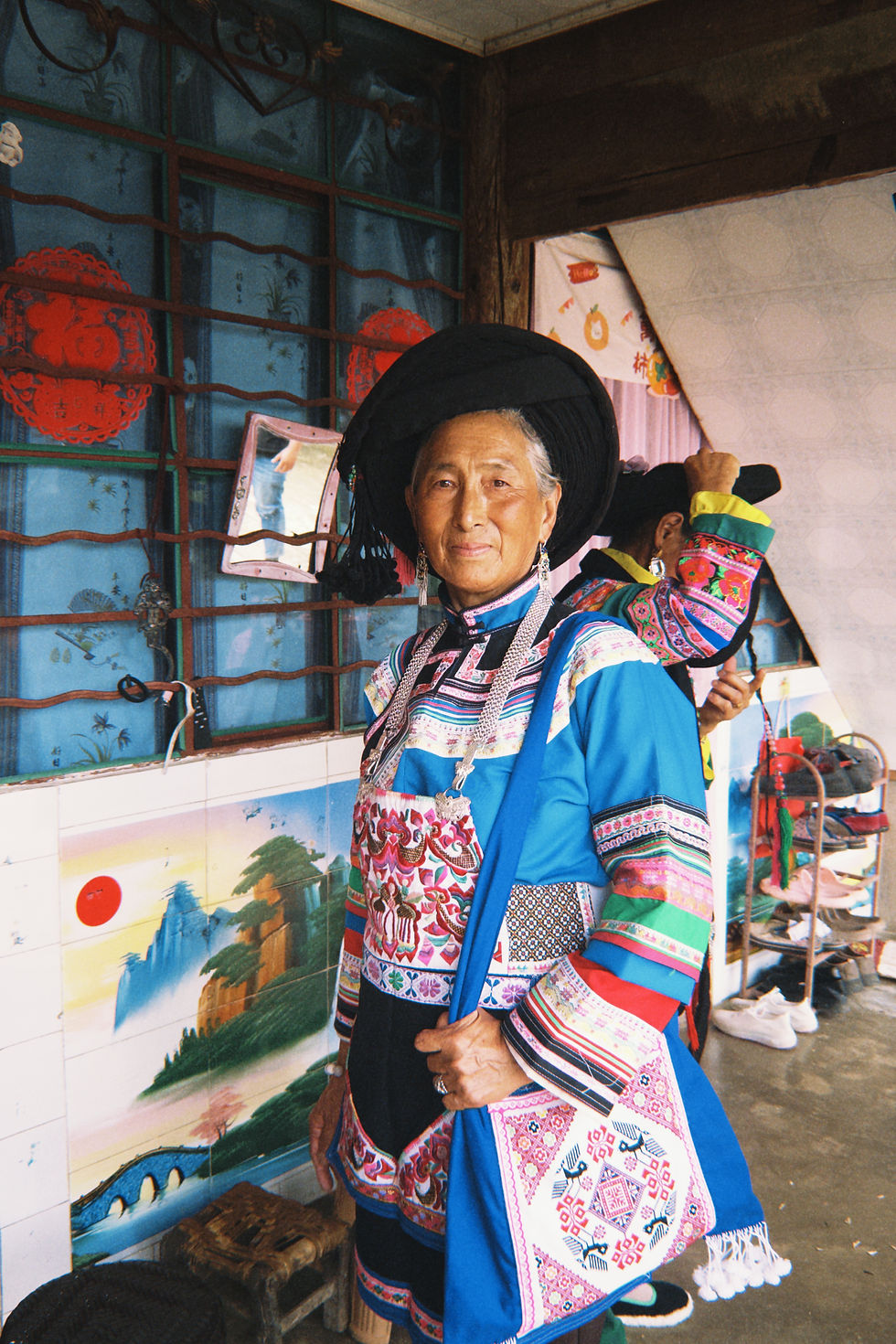Threads of flames – from Grandma Yang Qiaoying’s eyes
- Diane Yu
- Aug 24
- 4 min read
The afternoon sun in Yangliu village draped everything in gold — the tiled rooftops, the drying chili strings, the hands of Grandma Yang Qiaoying as they worked a bright, geometric pattern into a square of cloth.
The courtyard smelled faintly of pine smoke and camellia tea. Somewhere in the distance, a rooster crowed lazily, as if to remind us that time here moved at its own pace.
She began telling her story almost before I had the chance to ask. Life, she said, had never been easy. Her husband, “very much the boss at home,” always believed that a man’s word should be law. In those days, she mostly kept quiet, tending the children, the house, and the small vegetable plot. Then came the harder years. When she was in her forties, her husband passed away. Before that, they had already suffered from having one extra son during the years of the one-child policy. What was even worse is that her husband lost his job and spent one year and eight months in prison during this arduous phase.
With three children to raise and only a meager wage, she carried the household alone on her frail yet firm shoulders. “Sometimes,” she said, her needle pausing in mid-air, “we barely had enough rice. I remember boiling just sweet potato leaves for dinner. But I told myself — if I keep walking, there will be a road.”

Her voice softened as she spoke of her children. “My daughters and my son — they’re all very filial now. That’s the reward. You work hard, and in the end, you get respect, you get love. It’s worth it.” Her eyes shone with quiet pride, though her hands never stopped moving, the flying tip of the silver needle pulling the bright thread through the taut fabric.
When I asked about Bai and Yi traditions (ethnic minority groups that she belonged to) in the mountains, her whole demeanor lifted.
July had just passed, which meant the village had recently celebrated the Torch Festival. She leaned closer and began to recount an old tale: a young couple was picking wild fruit in the hills; the man was attacked by a wild boar, his belly torn. The girl carried him back to a stable and played a mournful tune for him, but her family disapproved of him lying there. He died, and the villagers burned his body. She leapt into the flames to follow him.
“Every year,” she continued, “we wear our most beautiful clothes. We sing, we dance, we light the torches. The flames carry our thoughts to the ones we love — even to those we can’t see anymore.”

I pictured the scene she described: the mountain night lit up by hundreds of small fires, music winding through the dark along the fog, the air around heavy with the scent of burning woods.
The image lingered long after she had moved on to another topic — how many Yi embroidery motifs came directly from this tragic love story. Unlike Bai embroidery, which flows freely from the maker’s imagination, Yi embroidery is bound to tradition, its patterns illustrating a bridge, ranging from the past to present.
She showed me the piece in her lap — red, black, and gold shapes that seemed to shift as the light touched them. It was called Shizi Xiu (cross-stitch), a technique that demands absolute precision.
“One wrong step and the whole piece is flawed. You’ll have to start over again. You can unpick a mistake,” she explained, “but the cloth will always carry the scar with it.”
In her eyes, this was part of the beauty and perfection— that every piece bore the invisible memory of the hands that made it.
Shizi Xiu patterns and the special embroidering skills from Yu traditions, she told me, are often more abstract, more deliberate, their geometry echoing designs passed down for generations. Some are meant to resemble flames, others the outlines of mountains, still others the winding path of a river — symbols of love, endurance, and the stubborn will to survive.
Sometimes, the German Misor Foundation comes to the village to teach embroidery techniques to groups of twenty or thirty. Foreign visitors — especially from Hong Kong and Europe — often pay more, not just in money. “They value the work,” she said, “they see it as something to treasure. That makes me happy. We’re not just making clothes and stitches- indeed, we’re passing the torch on to the next younger generation.”
Outside, the light began to fade, and the hills turned the color of deep tea. The air grew cooler, and a neighbor’s laughter drifted over the low wall. In her lap, the half-finished embroidery glowed under the gloomy hues of the daylight. The needle caught the last slanting rays of sunlight, flashing gold like a miniature torch. It seemed as though she wasn’t just stitching patterns — she was stitching the very story of her life, one careful loop at a time.



Comments